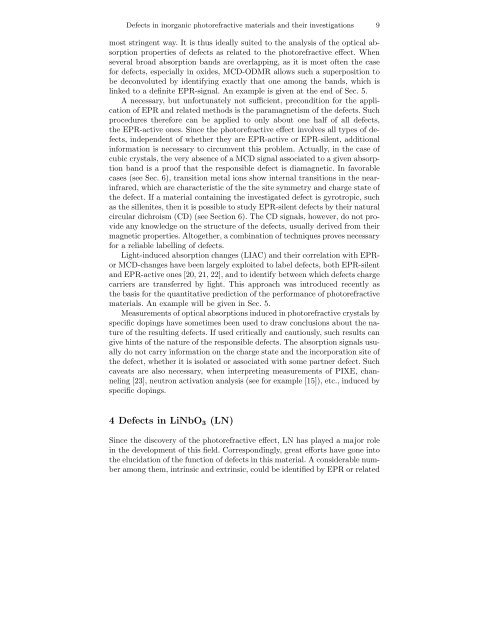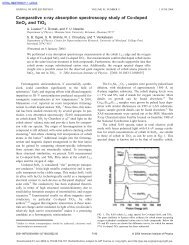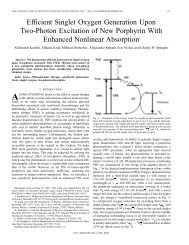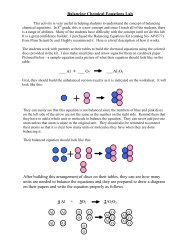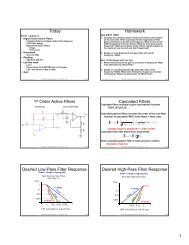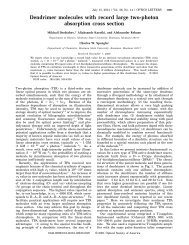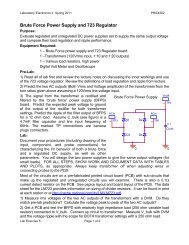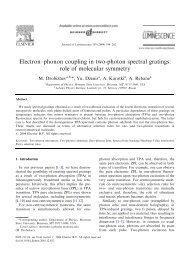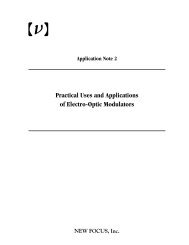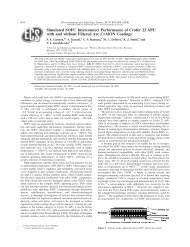Defects in inorganic photorefractive materials and their investigations
Defects in inorganic photorefractive materials and their investigations
Defects in inorganic photorefractive materials and their investigations
You also want an ePaper? Increase the reach of your titles
YUMPU automatically turns print PDFs into web optimized ePapers that Google loves.
<strong>Defects</strong> <strong>in</strong> <strong>in</strong>organic <strong>photorefractive</strong> <strong>materials</strong> <strong>and</strong> <strong>their</strong> <strong>in</strong>vestigations 9<br />
most str<strong>in</strong>gent way. It is thus ideally suited to the analysis of the optical absorption<br />
properties of defects as related to the <strong>photorefractive</strong> effect. When<br />
several broad absorption b<strong>and</strong>s are overlapp<strong>in</strong>g, as it is most often the case<br />
for defects, especially <strong>in</strong> oxides, MCD-ODMR allows such a superposition to<br />
be deconvoluted by identify<strong>in</strong>g exactly that one among the b<strong>and</strong>s, which is<br />
l<strong>in</strong>ked to a def<strong>in</strong>ite EPR-signal. An example is given at the end of Sec. 5.<br />
A necessary, but unfortunately not sufficient, precondition for the application<br />
of EPR <strong>and</strong> related methods is the paramagnetism of the defects. Such<br />
procedures therefore can be applied to only about one half of all defects,<br />
the EPR-active ones. S<strong>in</strong>ce the <strong>photorefractive</strong> effect <strong>in</strong>volves all types of defects,<br />
<strong>in</strong>dependent of whether they are EPR-active or EPR-silent, additional<br />
<strong>in</strong>formation is necessary to circumvent this problem. Actually, <strong>in</strong> the case of<br />
cubic crystals, the very absence of a MCD signal associated to a given absorption<br />
b<strong>and</strong> is a proof that the responsible defect is diamagnetic. In favorable<br />
cases (see Sec. 6), transition metal ions show <strong>in</strong>ternal transitions <strong>in</strong> the near<strong>in</strong>frared,<br />
which are characteristic of the the site symmetry <strong>and</strong> charge state of<br />
the defect. If a material conta<strong>in</strong><strong>in</strong>g the <strong>in</strong>vestigated defect is gyrotropic, such<br />
as the sillenites, then it is possible to study EPR-silent defects by <strong>their</strong> natural<br />
circular dichroism (CD) (see Section 6). The CD signals, however, do not provide<br />
any knowledge on the structure of the defects, usually derived from <strong>their</strong><br />
magnetic properties. Altogether, a comb<strong>in</strong>ation of techniques proves necessary<br />
for a reliable labell<strong>in</strong>g of defects.<br />
Light-<strong>in</strong>duced absorption changes (LIAC) <strong>and</strong> <strong>their</strong> correlation with EPRor<br />
MCD-changes have been largely exploited to label defects, both EPR-silent<br />
<strong>and</strong> EPR-active ones [20, 21, 22], <strong>and</strong> to identify between which defects charge<br />
carriers are transferred by light. This approach was <strong>in</strong>troduced recently as<br />
the basis for the quantitative prediction of the performance of <strong>photorefractive</strong><br />
<strong>materials</strong>. An example will be given <strong>in</strong> Sec. 5.<br />
Measurements of optical absorptions <strong>in</strong>duced <strong>in</strong> <strong>photorefractive</strong> crystals by<br />
specific dop<strong>in</strong>gs have sometimes been used to draw conclusions about the nature<br />
of the result<strong>in</strong>g defects. If used critically <strong>and</strong> cautiously, such results can<br />
give h<strong>in</strong>ts of the nature of the responsible defects. The absorption signals usually<br />
do not carry <strong>in</strong>formation on the charge state <strong>and</strong> the <strong>in</strong>corporation site of<br />
the defect, whether it is isolated or associated with some partner defect. Such<br />
caveats are also necessary, when <strong>in</strong>terpret<strong>in</strong>g measurements of PIXE, channel<strong>in</strong>g<br />
[23], neutron activation analysis (see for example [15]), etc., <strong>in</strong>duced by<br />
specific dop<strong>in</strong>gs.<br />
4 <strong>Defects</strong> <strong>in</strong> LiNbO 3 (LN)<br />
S<strong>in</strong>ce the discovery of the <strong>photorefractive</strong> effect, LN has played a major role<br />
<strong>in</strong> the development of this field. Correspond<strong>in</strong>gly, great efforts have gone <strong>in</strong>to<br />
the elucidation of the function of defects <strong>in</strong> this material. A considerable number<br />
among them, <strong>in</strong>tr<strong>in</strong>sic <strong>and</strong> extr<strong>in</strong>sic, could be identified by EPR or related


